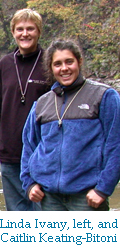New Study Reveals Ozone’s Hidden Toll on America’s Trees
A new nationwide study reveals that ozone pollution—an invisible threat in the air—may be quietly reducing the survival chances of many tree species across the United States. The research, published in the Journal of Geophysical Research: Atmospheres is the first…


 The
The  SU Alumnus Caitlin Keating-Bitonti ’09 is the corresponding author of the study. She conducted the research as an undergraduate student under the guidance of Linda Ivany, associate professor of earth sciences, and Scott Samson, professor of earth sciences, both in Syracuse University’s
SU Alumnus Caitlin Keating-Bitonti ’09 is the corresponding author of the study. She conducted the research as an undergraduate student under the guidance of Linda Ivany, associate professor of earth sciences, and Scott Samson, professor of earth sciences, both in Syracuse University’s